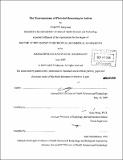| dc.contributor.advisor | Maria Mody. | en_US |
| dc.contributor.author | Sahyoun, Chérif P | en_US |
| dc.contributor.other | Harvard University--MIT Division of Health Sciences and Technology. | en_US |
| dc.date.accessioned | 2010-04-28T17:05:55Z | |
| dc.date.available | 2010-04-28T17:05:55Z | |
| dc.date.copyright | 2009 | en_US |
| dc.date.issued | 2009 | en_US |
| dc.identifier.uri | http://hdl.handle.net/1721.1/54589 | |
| dc.description | Thesis (Ph. D.)--Harvard-MIT Division of Health Sciences and Technology, 2009. | en_US |
| dc.description | Cataloged from PDF version of thesis. | en_US |
| dc.description | Includes bibliographical references (p. 163-177). | en_US |
| dc.description.abstract | Individuals with autism present with a constellation of social, behavioral, and cognitive symptoms. A striking characteristic is the contrast between their language and visual processing abilities. The work in this thesis combines behavioral, functional MRI, and diffusion tensor imaging methods to examine the neurobiological basis of the discrepancy between linguistic and visuospatial skills in autistic cognition. A pictorial reasoning task, designed to manipulate the degree to which language vs. visuospatial abilities may be differentially engaged in solving picture puzzles, was administered under three conditions: visuospatial, semantic and a hybrid visuospatial-cum-semantic condition. Whereas participants with Asperger's syndrome and typically developing controls (CTRL) were found to exhibit similar performance profiles, high-functioning individuals with autism (HFA) differed from these two groups: they were least efficient on the semantic condition and appeared to benefit from and favor the use of visuospatial mediation in problem solving. Results from functional MRI revealed a pattern of decreased activation in fronto-temporal language areas, and an increased reliance on posterior brain regions in the parietal and ventral temporal lobes in HFA, supporting the earlier behavioral findings. Specifically, the inferior frontal gyrus appeared to play an important role in verbal mediation and semantic integration in CTRL, whereas HFA relied more extensively on inferior and ventral regions of the temporal lobe, in keeping with a cognitive preference for visual strategies. | en_US |
| dc.description.abstract | (cont.) An examination of white matter integrity yielded a similar finding in the relationship between structural neuroanatomy and cognitive profile, such that connectivity patterns were related to the semantic mediation difficulties and visual processing preference in the HFA group: tracts relevant for semantic processing in CTRL were disrupted in HFA along the superior longitudinal fasciculus and in the frontal lobe, whereas parietal and inferior temporal white matter supporting visuospatial processing were intact in HFA The results suggest that performance in high functioning autism may be related to deficits in frontal cortex connectivity, in favor of visualization strategies in higher-level cognition. The findings appear to support the use of visuospatial vs. linguistic tasks to differentiate between potential subtypes on the autism spectrum. | en_US |
| dc.description.statementofresponsibility | by Chérif P. Sahyoun. | en_US |
| dc.format.extent | 177 p. | en_US |
| dc.language.iso | eng | en_US |
| dc.publisher | Massachusetts Institute of Technology | en_US |
| dc.rights | M.I.T. theses are protected by
copyright. They may be viewed from this source for any purpose, but
reproduction or distribution in any format is prohibited without written
permission. See provided URL for inquiries about permission. | en_US |
| dc.rights.uri | http://dspace.mit.edu/handle/1721.1/7582 | en_US |
| dc.subject | Harvard University--MIT Division of Health Sciences and Technology. | en_US |
| dc.title | The neuroanatomy of pictorial reasoning in autism | en_US |
| dc.type | Thesis | en_US |
| dc.description.degree | Ph.D. | en_US |
| dc.contributor.department | Harvard University--MIT Division of Health Sciences and Technology | |
| dc.identifier.oclc | 569514961 | en_US |
